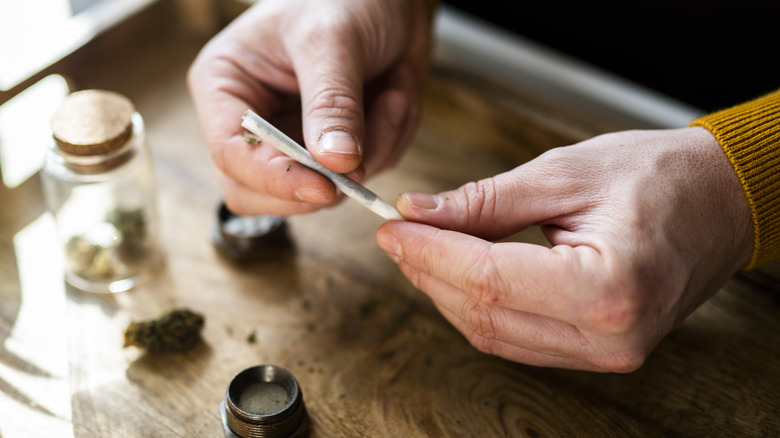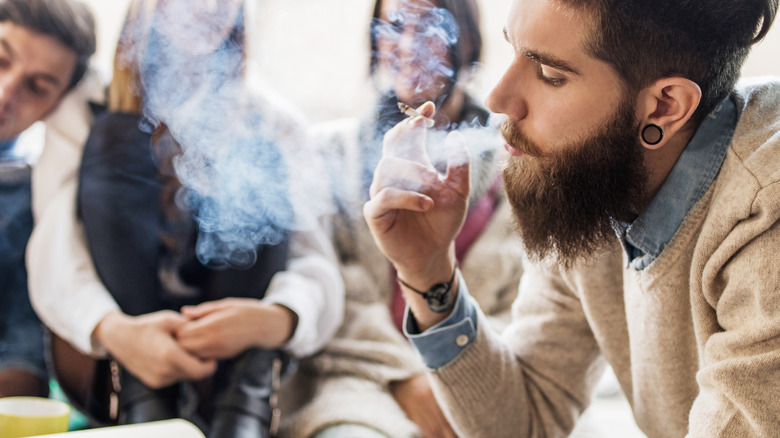Marijuana Side Effects That Differ Between Men And Women
Out of the most commonly used substances globally, marijuana comes in at number two next to alcohol, according to a 2020 academic review published in the International Journal of Environmental Research and Public Health. In assessing marijuana usage amongst U.S. adults between 2013 and 2022, the results of a Gallup poll show that use of the drug is on the rise. While 7% of Americans reported smoking weed back in 2013, that number jumped to 16% in 2022.
Marijuana usage was observed across all stages of adulthood, although rates were shown to drop with age. While 30% of individuals between the ages of 18 and 34 reported smoking pot, only 16% of middle-aged adults and 7% of older adults said the same. In addition to age, the poll also looked at rates of marijuana use across gender. Although a greater percentage of men reported smoking weed, it wasn't by much — just 4%. A total of 14% of women reported using pot, compared to 18% of men. Researchers from the 2020 academic review also highlighted a study in which it was found that out of 1,210 transgender adults, more than 24% of individuals utilized marijuana, with use being more common amongst transgender men than transgender women.
Common side effects of marijuana
Marijuana intoxication can have both immediate and long-term side effects. According to the National Institute on Drug Abuse, tetrahydrocannabinol (THC), which gives weed its psychoactive effects, is promptly dispersed into the bloodstream after being inhaled into the lungs, where it is then circulated to the brain and the rest of the body. Within minutes, a person may experience various side effects ranging from shifts in mood to impaired memory, difficulty with physical movements, trouble thinking clearly, hallucinations, or changes in one's perception of colors or time. When ingested, absorption of the drug into the body takes longer, and it may take anywhere from a half-hour to an hour before these effects take hold.
In the long run, ongoing marijuana use may lead to paranoia, impaired thinking or learning ability, respiratory issues, and may potentially increase a person's risk of heart problems. While anyone of any gender may experience these different side effects and many more, studies have shown that men and women tend to experience some specific side effects more than others.
Differences in biological and behavioral side effects of marijuana use between men and women
The different ways in which marijuana use affects both biology and behavior across sex have been the subject of research in both human and animal studies. In a 2016 study published in Cannabis and Cannabinoid Research, researchers used anonymous survey data from 2,374 individuals who reported using cannabis in order to determine which side effects were more common amongst men versus women. It was found that enthusiasm, an altered sense of time, and boosts in musicality and memory were seen more often in association with men than women. Men were also found to be more susceptible to the munchies. Women tended to report decreases in appetite and an urge to clean (which some interpreted as personal hygiene practices or tidying up).
The researchers also referenced findings of alternate studies previously conducted on the same subject matter. In one study, dizziness as a result of marijuana use was more strongly correlated with women. Other studies have found that men tend to be more prone to poor decision-making, while better decision-making was seen more in relation to women cannabis users. Compared to people who were not marijuana users, another study showed that men took more time on timed cognitive tests than women.
While these studies focused specifically on men and women, it's important to note that sex and gender are not binary and are therefore not exclusive to only males and females or men and women.
Some side effects of marijuana do not vary by sex
Researchers from a 2010 scientific review published in the British Journal of Pharmacology also assessed existing studies involving females and males and the side effects associated with marijuana use. They found that side effects related to numbness, motor activity, depression, anxiety, catalepsy, and increases in sexual behavior and arousal were more strongly correlated with females. Side effects from cannabis usage related to food intake, energy balance, and decreases in sexual behavior and arousal were more common in males.
The study team also made note of which weed-related side effects did not appear to vary by sex. This included those in relation to stress, impulsivity, learning, cognition, reward, memory, addiction, and hypothermia. Further research is still needed, however, as some of these findings are contrary to those previously discussed. Additionally, the researchers noted that studies regarding differences in rates of marijuana addiction in males and females have yielded contradictory results between clinical and animal trials. Scientific claims of hypothermia in relation to marijuana use are also still debated.
Differences between men and women in marijuana use habits
Differences between men and women have also been observed when it comes to the means by which a person chooses to use marijuana, such as smoking, vaping, or ingesting edibles. In the previously mentioned 2016 study, researchers noted that men generally lean more towards joints, blunts, bongs, concentrates, and vaporizers, while women are more inclined towards the use of pipes, edibles, tinctures, and capsules. In looking more closely at participant smoking habits, the research findings showed that men were more likely to take a greater number of puffs during a smoking session than women.
When asked about the age at which they first started using marijuana, results were similar between men and women amongst six of the age brackets laid out by the researchers: younger than 14, ages 14 through 16, ages 17 through 18, ages 19 through 20, ages 21 through 25, and ages 26 through 30. However, the number of women who reported first-time marijuana use after the age of 30 was double that of the number of men.
The contrast between men and women was also seen in regards to reasons why a person may use cannabis. More than 73% of men and over 65% of women reported doing so recreationally. Using marijuana for medicinal health reasons, however, was more evident among women (64.1%) compared to men (54.3%). Approximately the same percentage of both men and women reported using marijuana in association with religion.
Why these differences may exist
Marijuana usage isn't the only area in which men and women may differ in terms of side effects experienced. Rather, there are also differences observed between the two groups in relation to stopping use of the drug. Men more often reported sleep-related withdrawal symptoms, specifically insomnia and vivid dreams, according to the 2016 study. Women more often voiced withdrawal symptoms of anxiety and nausea.
It's not entirely clear as to why all of these differences exist across sex and gender in regards to marijuana use and related side effects. However, experts theorize that various biological and physiological factors are likely at play, including variance in metabolism, sex hormones, organ function, speed of absorption, and more (via the International Journal of Environmental Research and Public Health). In regards to differences in patterns of marijuana use, societal and demographic factors are thought to play a role, such as socioeconomic status, race, stigma, and sexual orientation, as well as who these products are predominantly marketed to. Awareness of this information can help policymakers more effectively address issues of public health surrounding marijuana use.
If you or anyone you know needs help with addiction issues, help is available. Visit the Substance Abuse and Mental Health Services Administration website or contact SAMHSA's National Helpline at 1-800-662-HELP (4357).






